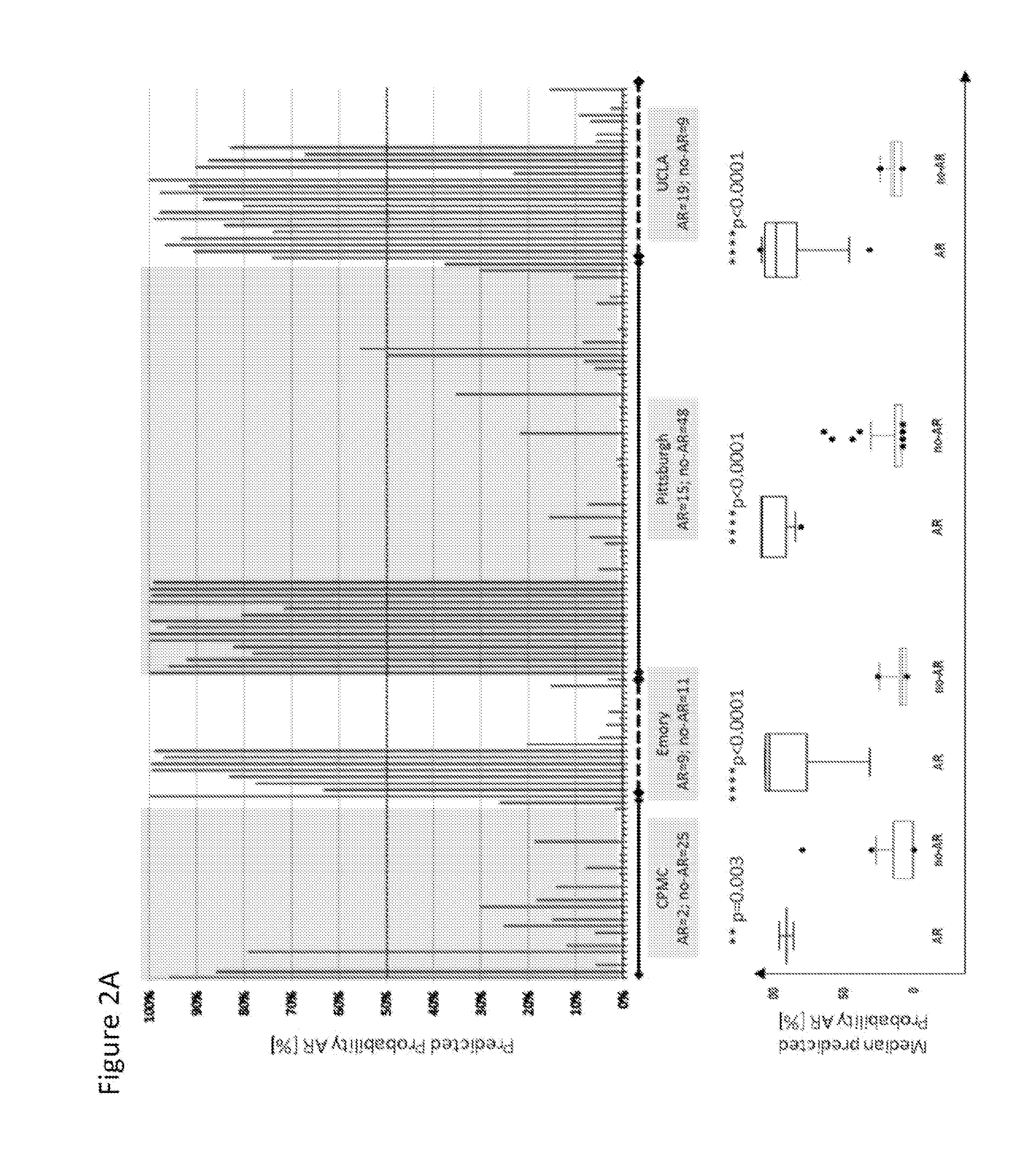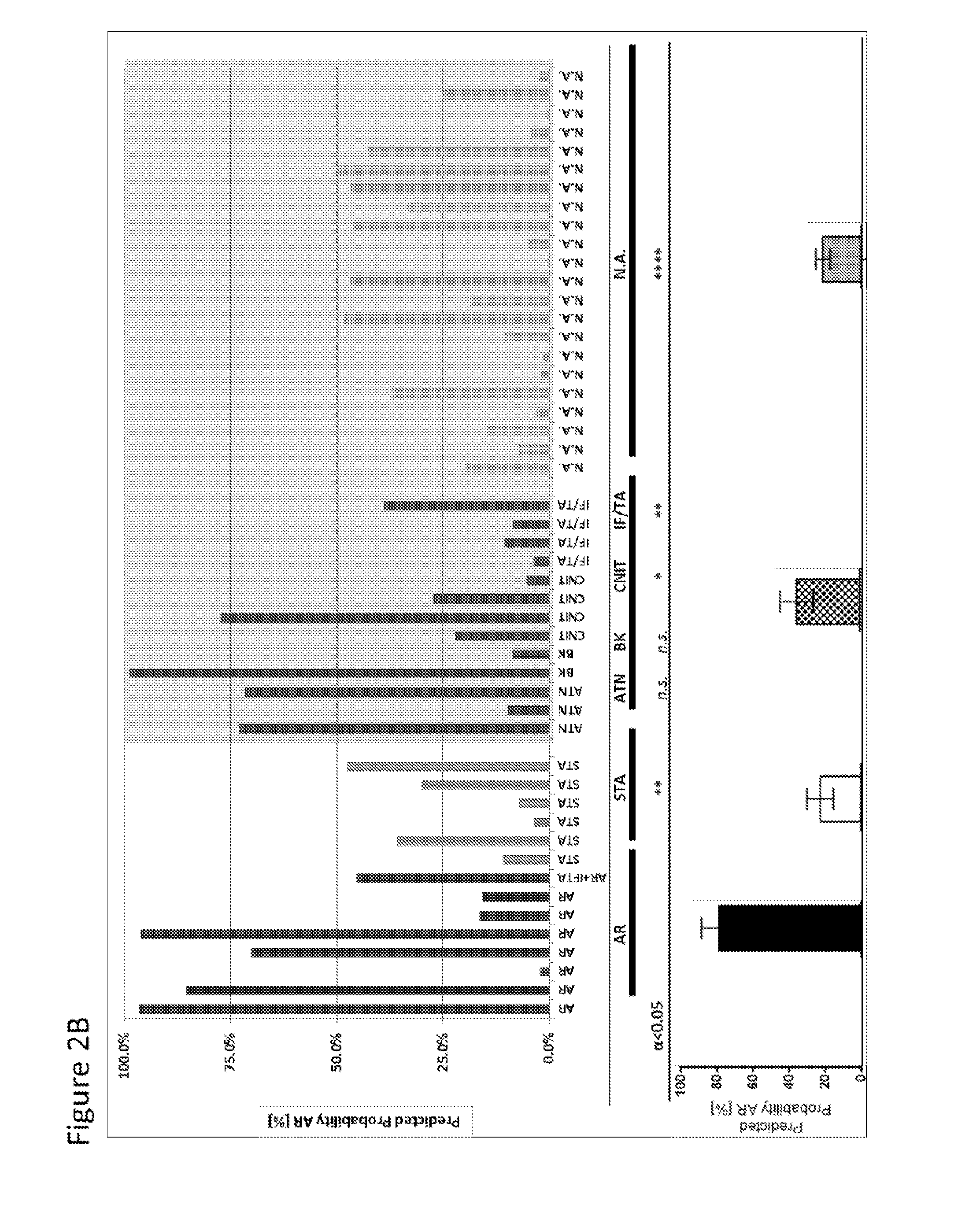Compositions and methods for assessing acute rejection in renal transplantation
a technology for acute rejection and kidney transplantation, applied in the direction of drug compositions, urinary disorders, biochemistry apparatus and processes, etc., can solve the problems of inability to perform biopsies, inability to detect acute rejection of solid organ transplantation, and lack of sensitive, specific, and non-invasive assays
- Summary
- Abstract
- Description
- Claims
- Application Information
AI Technical Summary
Benefits of technology
Problems solved by technology
Method used
Image
Examples
example 1
Study Design for Development of Compositions and Methods for Assessing Acute Rejection in Renal Transplantation
[0113]The Assessment of Acute Rejection in Renal Transplantation (AART) Study was designed in a collaborative effort in 8 renal transplant centers worldwide and utilized 558 peripheral blood (PB) samples from 438 adult and pediatric renal transplant patients for developing a simple blood QPCR test for acute rejection (AR) diagnosis and prediction in recipients of diverse ages, on diverse immunosuppression, and subject to Transplant Center specific protocols.
[0114]FIG. 1 describes the Assessment of Acute Rejection in Renal Transplantation (AART) Study Design in 438 unique adult / pediatric renal transplant patients from 8 transplant centers worldwide: Emory, UCLA, UPMC, CPMC, UCSF, and Barcelona contributed adult-, Mexico, and Stanford pediatric samples. For AR QPCR analysis, samples were divided into 4 Cohorts: Cohort 1 n=143 adult samples for gene modeling; Cohort 2 n=124 ad...
example 2
Blood Samples
[0116]Peripheral blood samples (n=518) that originated from unique pediatric (recipient age at transplant=0.8-21.9 years; n=200) and adult (recipient age at transplant=23-78 years; n=315) kidney transplant recipients were used for the development of a common peripheral blood gene panel for non-invasive diagnosis of biopsy-confirmed acute renal allograft rejection. Within the pediatric cohort of 200 samples, 177 samples were previously obtained as part of a prospective multicenter NIH / NIAID-funded clinical trial in which patients both with and without histological-graded AR were enrolled from 12 U.S. transplant centers (SNS01; NCT00141037; www.ClinicalTrials.gov; Li, L., et al. Am. J. Transplant. 2012, 12, 2710-2718). The remaining 23 samples were exclusively obtained for this study from the Laboratorio de Investigacion en Nefrologia, Hospital Infantil de Mexico. Within the adult cohort of 315 samples, samples were from obtained from 6 transplant centers in the U.S. and ...
example 3
Patients
[0118]Adult and Pediatric Set I
[0119]Table 5 shows the Adult and Pediatric Set I.
[0120]In one example, the combined pediatric and adult samples were separated into two groups for testing (n=236; 143 adult, 93 pediatric) and validation (n=292; 208 adult, 84 pediatric, Table 5).
Adult and Pediatric Set II
[0121]In another example, the combined pediatric and adult samples were separated into three groups for training and testing (n=143 adult), for validation (n=124; 59 adult, 65 pediatric), and for independent prediction (n=191; 130 adult, 61 pediatric, Table 4).
Adult and Pediatric Set III
[0122]In another example, the combined pediatric and adult samples were separated into 100 samples for validation (77 adult, 23 pediatric, Table 4).
PUM
| Property | Measurement | Unit |
|---|---|---|
| Fraction | aaaaa | aaaaa |
| Time | aaaaa | aaaaa |
| Gene expression profile | aaaaa | aaaaa |
Abstract
Description
Claims
Application Information
 Login to View More
Login to View More - R&D
- Intellectual Property
- Life Sciences
- Materials
- Tech Scout
- Unparalleled Data Quality
- Higher Quality Content
- 60% Fewer Hallucinations
Browse by: Latest US Patents, China's latest patents, Technical Efficacy Thesaurus, Application Domain, Technology Topic, Popular Technical Reports.
© 2025 PatSnap. All rights reserved.Legal|Privacy policy|Modern Slavery Act Transparency Statement|Sitemap|About US| Contact US: help@patsnap.com



